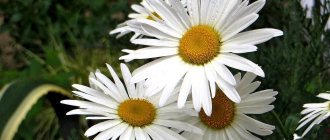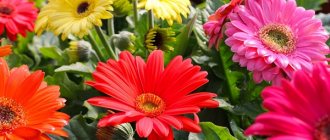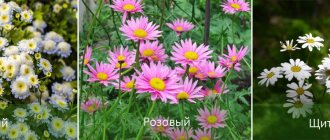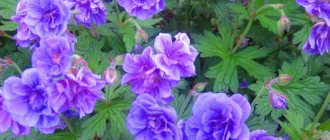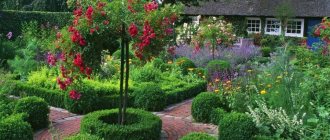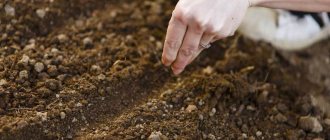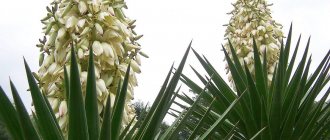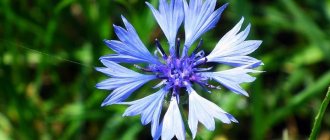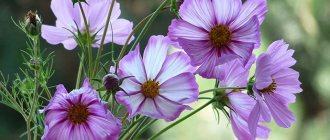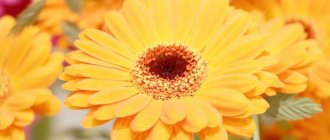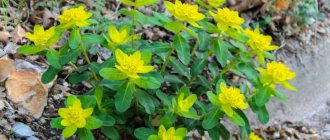Garden chamomile: the birthplace of the plant and options for use in garden decoration
The countries of the Mediterranean, South Africa and East Asia are considered the birthplace of modern large garden chamomile, where it grows in natural conditions. In our country it is grown as an ornamental plant in gardens. Thanks to its unpretentiousness, discreet beauty and long flowering, it has found wide application in landscape design. It is used to decorate flower beds, mixborders, lawns and borders.
The flower is especially suitable for areas decorated in a rustic style. In this case, they are planted near the porch of the house, around tall trees and in the recreation area. In flowerbeds and lawns they are combined with mint, lemon balm, yarrow and calendula. They also look great against the backdrop of tall decorative poppies and surrounded by marigolds.
In our country, garden chamomile is grown as an ornamental plant in gardens.
Chamomile: characteristics of plant species
Decorative garden chamomile has a large number of varietal varieties. The most common of them include:
- North Star. This is a very common and popular variety among gardeners. A branched, strong bush grows up to seventy centimeters in height. The flowers are quite large, blooming lasts from early summer until autumn;
- Garden princess. The most common chamomile found in garden plots. Its dense and elastic shoots reach up to thirty-five centimeters in height. Large inflorescences reach ten centimeters in diameter. This variety begins to bloom in mid-July and continues until early October;
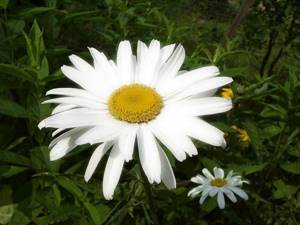
North Star is a very common and popular variety among gardeners.
- Silver Princess. This variety is a low-growing plant; it reaches a height of no more than thirty centimeters. Moreover, the plant has fairly large flowers that begin to bloom in July. This species blooms before frost;
- Alaska. This is the largest-flowered garden daisy, up to ninety centimeters high. Its flowers reach twelve centimeters in diameter. This is a drought-resistant variety that blooms briefly towards the end of summer;
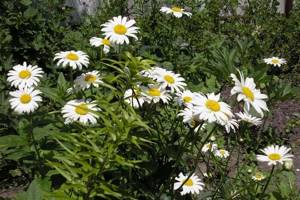
Silver Princess - the variety belongs to low-growing plants, it reaches a height of no more than thirty centimeters
- Winner. The height of this varietal variety ranges from fifty to ninety centimeters, and the flowers reach a diameter of eight to twelve centimeters. Flowering begins in June and ends in August;
- Aglaya. A very beautiful variety, the bushes of which grow up to eighty centimeters. Large double flowers have a chrysanthemum-like shape; around the bright yellow center there are several rows of narrow petals of different lengths, dissected at the ends. The flowering of this variety lasts from early summer until autumn;
- Maiden chamomile Solar ball. This bushy, low-growing varietal variety is not like ordinary garden daisies. It is compact, the height of the bush reaches no more than thirty centimeters. Its small flowers, up to two centimeters in diameter, look like air cushions and are completely painted in bright yellow. Flowering continues throughout the summer.
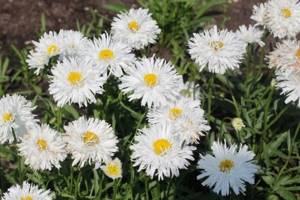
Aglaya is a very beautiful variety, the bushes of which grow up to eighty centimeters
Garden chamomile: technology for planting and care in open ground
Regardless of what type and color of garden chamomile, the rules for caring for it are the same. They are not difficult and even beginners in gardening can do them. This flower is unpretentious, but if you pay a little attention to it, its development will go much faster, and the flowering will be much more abundant.
Site selection
To plant garden chamomile, you should choose a fairly sunny area with well-drained sandy soil with neutral acidity. If the soil is very acidic, then dolomite flour and slaked lime should be added to it in the autumn.
Features of growing garden chamomile (video)
Landing
Before planting, you need to dig up the selected area well and fill it with humus at the rate of one bucket per square meter. After this, you need to dig it up again and make shallow holes at intervals of about thirty centimeters. Pour one glass of ash into each and plant seedlings. Water the sediment and mulch it with peat or sawdust. The gaps between the holes should be filled with ammonium nitrate, twenty grams per square meter. This will allow the plants to quickly gain green mass.

Before planting garden chamomile, you need to dig up the selected area well and fill it with humus at the rate of one bucket per square meter
Watering and fertilizing
Since garden chamomile is a rather large plant that loves moisture, watering should be regular and plentiful. But the soil should not be allowed to become waterlogged, which leads to rotting of the root system.
Feeding is of great importance for the proper development of the plant. The first time it is carried out during the formation of buds using complex mineral fertilizers. Then it is repeated every two weeks in order to obtain large inflorescences.
Weeding and bush formation
Garden chamomile does not tolerate being close to weeds, so it requires regular weeding and loosening, which will ensure air flow to the roots. In order for the bush to have a neat shape and the inflorescences to be large, the secondary stepsons that form in the axils of the leaves should be regularly removed .
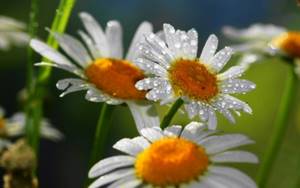
Garden chamomile is a fairly large plant that loves moisture, so watering should be regular and plentiful.
Transfer
Garden chamomile can grow in one place for up to five years. But, usually, in the third year of growth, the bushes become too dense, and their inner part begins to die off. In order to preserve the spectacular and decorative appearance of the plant, it should be replanted at this moment. It is advisable to do this in the autumn, after flowering has ended. To replant, you need to choose a cloudy day, dig up a garden chamomile bush and separate well-developed young shoots from it and plant them in a prepared area.
Preparing for winter
At the end of autumn, you need to prepare your garden chamomile for winter. To do this, you need to cut off the entire above-ground part of the plant and mulch the area. After this, it should be covered with dry leaves and covered with spruce branches. In winter, you can additionally cover the plantings with snow.
Chamomile
Chamomile is an annual herbaceous plant of the Asteraceae family, with a strong bitter odor. The stem is up to 60 cm in height, quite thick, branched from the base. Leaves are alternate, doubly pinnate. The yellow flower baskets are medium-sized, sitting on short, thickened peduncles at the top. The fruit is an achene with two resinous stripes and mucous cells in the lower part. It blooms in July–September, the fruits ripen in August–September. It grows in courtyards, on streets, vacant lots, along dirt roads and their sides, forest clearings, clearings on fresh sandy loam soils, and also as a weed in agricultural crops. For medicinal purposes, use Matricaria recutita - chamomile or Matricaria discoidea - chamomile without tongue , or odorous .
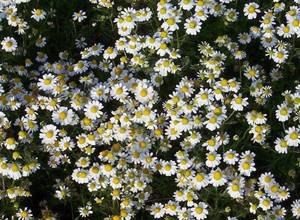
The plant is quite decorative and can be used in high borders, in group plantings on the lawn (this is how the famous English garden designer John Brooks uses chamomile) and along fences and walls. Main medicinal purpose: anti-inflammatory, antispasmodic, diaphoretic, sedative. Chamomile essential oil contains the substance chamazulene, which has anti-inflammatory, antiallergic, and anesthetic effects. Azulene has an antiallergic effect and accelerates tissue regeneration and healing. Apigenin and apiin relieve spasms of the smooth muscles of internal organs. Flavonoids, coumarins, ascorbic acid, pectins, carotene and other compounds were also found in the inflorescences. These substances have anti-inflammatory, antibacterial, immunomodulatory, wound-healing and antioxidant effects. You need to know that you cannot boil or steep chamomile flowers with boiling water, since this will result in the loss of the most valuable component of the plant - chamazulene. Useful recipes: Soothing tea Brew a teaspoon of chamomile flowers in a glass of hot water, like regular tea. Leave for 1 hour. Drink not hot, before bed, adding a teaspoon of honey for severe fatigue and insomnia.
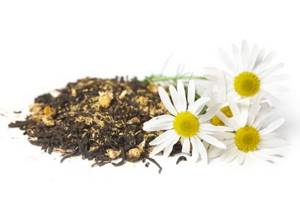
CARE RECOMMENDATIONS
Lighting: Sunny place or light partial shade
Soil: Loose
Watering: Undemanding. However, seed germination and rooting of seedlings is possible only with high moisture in the top layer of soil.
Fertilizing: Adding organic matter to the soil allows you to grow in one place for 3–4 years due to abundant self-sowing
Reproduction: Seeds are sown in a pharmacy bed and in natural-style flower beds before winter or spring, without covering them with soil. To preserve the population when collecting for each square. m leave 2-3 plants
Diseases and pests: No damage
Methods and technology for propagating chamomile in the garden
Garden chamomile is propagated by dividing the bush and by seed. But in order to grow a full-fledged plant, you need to know how to do it correctly.
Propagation by seeds
Garden chamomile seeds can be sown directly into the ground in the spring. But, in this case, you will have to wait a very long time for the formation of a full-fledged adult plant, almost until the onset of autumn. Therefore, most often the seeds are used to grow seedlings.
To obtain seedlings, you need to prepare planting boxes with a good drainage layer and nutritious soil in early March. The seeds should be evenly distributed over its surface, sprinkled with a small layer of sand and carefully watered. Plantings should be covered with polyethylene and sent to a shaded room with an air temperature of twenty to twenty-five degrees. After the seedlings appear, the shelter should be removed, and after the formation of the third leaf on them, the seedlings should be picked into separate small pots. Seedlings should be planted in open ground only after the spring frosts have ended.
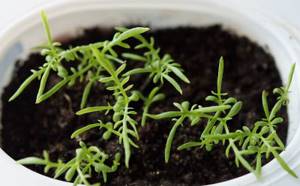
Most often, garden chamomile seeds are used for growing seedlings.
Reproduction by dividing the bush
Reproduction by dividing the bush is a more effective way to propagate garden chamomile , as it allows you to quickly obtain an adult flowering plant. To do this, in mid-spring or early autumn, you should select a well-developed large bush and carefully dig it out. After this, you need to clean the root system of excess soil, inspect it and remove dried and rotten roots. Divide the rhizome into several parts and plant them in separate holes, into which a little mineral fertilizer and ash should be added before planting.
Application
Dried and fresh chamomile is used in medicine: (decoctions, extracts) - as an anti-inflammatory, weak antiseptic and astringent, externally - for rinses, lotions and baths. Chamomile is taken orally as a tea (a traditional English home remedy) or infusion, and is used for intestinal spasms, flatulence and diarrhea, and as a diaphoretic. Preparations - Rekutan, Rotokan.
Chamomile extract is included in many cosmetic products, especially creams. Rinse hair with infusion of chamomile to give it a golden hue.
Essential oil of chamomile (“German chamomile”) is used in aromatherapy; more often - as a sedative. Due to its high price, it is often falsified, including being replaced with Roman chamomile oil - navel.
Blue, pink and red flowers similar to daisies
There are several types of plants that are very similar in type to garden chamomile, but have colored petals:
- Pyrethrum maiden or in other words Persian (Dalmatian) chamomile (Pyretrum parthenium). The plant is an unpretentious perennial, growing from fifty to one hundred centimeters in height. On strong long peduncles there are flowers with a diameter of six to twelve centimeters, having a bright yellow center surrounded by red petals. Currently, many hybrid forms of the plant have been developed with simple, semi-double and double inflorescences of pink, crimson, burgundy and yellow colors. Pyrethrum maidens blooms in June and continues throughout the summer;
- Erigeron or small petal (Erigeron). This perennial plant reaches a height of sixty to eighty centimeters. Its flowers are very similar to daisies and are characterized by a yellow center and narrow, densely spaced petals in blue, lilac, lilac, violet, red and pink. The diameter of the flower basket reaches five centimeters. This plant begins to bloom in early summer and continues until mid-August.
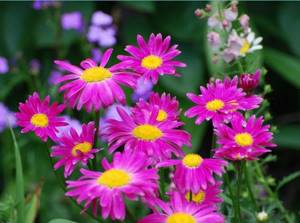
Persian chamomile is very similar in type to garden chamomile, but has colored petals
These plants can be harmoniously combined with garden daisies in various garden compositions. In addition, they have similar conditions of detention and care rules.
Why is the greatest cornflower confused with chamomile?
There are other flowers that inexperienced gardeners mistake for garden chamomile. They are called leucanthemum, or leucanthemum . This is due to the great external similarity of bushes and flowers. But if a comparative description of the plants is carried out, then some differences can be seen. Nielberry flowers are larger and more powerful than those of garden chamomile. In contrast to its thin, delicate, bright green leaves, cornflower foliage is dark green, very dense and tough, and has a solid crenate shape. Chamomile bushes branch quite strongly, and there are several flowers on each shoot. In Nielberry, one shoot corresponds to one flower.
Forms of release and methods of use of Roman chamomile: what is it suitable for in everyday life?
If pharmaceutical chamomile is most often presented in the form of dried flowers, then Roman chamomile is prepared both as a dried flower and as an essential oil.
The methods of use for these forms are different, but this does not diminish the benefits of the flower.
Dried chamomile flowers are best suited for making aromatic teas, inhalations and rinses.
Roman chamomile essential oil is suitable for compresses, massages, inhalations, baths and rinses.
The main thing here is the correct dosage.
| Mode of application | Essential oil dosage |
| Shared baths | 4-7 drops |
| Saunas (1 session) | 2-4 drops |
| Mouth rinses | 2-4 drops along with half a teaspoon of honey or salt per glass of water |
| Nasal drops for runny nose | 3-4 drops per 2 teaspoons of St. John's wort |
| Massage | 3-7 drops per 10 ml of base oil |
| Compresses | 15-20 drops per 40 drops of St. John's wort, wheat germ oil or black cumin |
| Additive to jams or honey | 4-6 drops per 100 ml of product |
| Ingestion for treatment or prevention | 1 drop per slice of bread or spoon of jam 2-3 times a day |
To make Roman chamomile essential oil even more beneficial, it is combined with other essential oils.
In this case, the following oil is perfect:
- Geraniums.
- Lavender.
- Roses.
- Neroli.
- Jasmine.
- Sage.
- Mha.
- Bergamot.
To prepare 1 liter of oil, you will need from 60 to 200 kg of chamomile inflorescences.
By the way, both oil and chamomile flowers are perfect for improving metabolism and the functioning of the digestive system in both adults and children.
And if you want to quickly overcome a hated cold or sore throat with the help of chamomile, here is the simplest recipe.
| Steps | Description |
| Step 1: Prepare your ingredients | You will need 1 tablespoon of dried chamomile flowers, 1 tablespoon of celandine and 200 ml of boiling water. |
| Step 2. Prepare the decoction | Brew dried flowers and cool the resulting decoction. For convenience, strain it if you are using simple dried flowers rather than bagged ones. |
| Step 3. Start treatment | Gargle with the resulting decoction 6 times a day, and within a few days you will see changes for the better. |
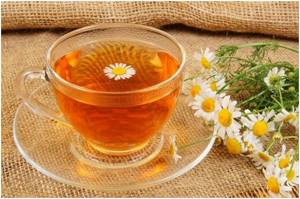
Benefits and preparation of chamomile tea:
